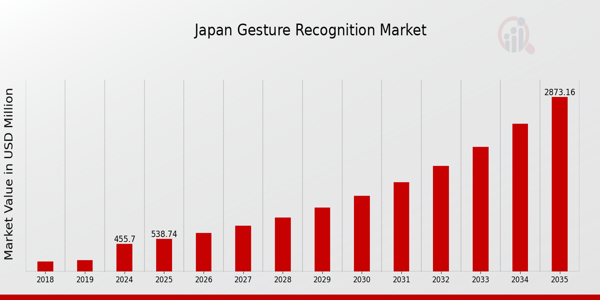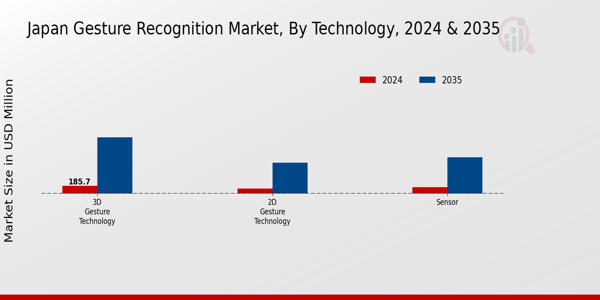Japan Gesture Recognition Market Overview
As per MRFR analysis, the Japan Gesture Recognition Market Size was estimated at 385.34 (USD Million) in 2023.The Japan Gesture Recognition Market Industry is expected to grow from 455.7(USD Million) in 2024 to 2,873.29 (USD Million) by 2035. The Japan Gesture Recognition Market CAGR (growth rate) is expected to be around 18.222% during the forecast period (2025 - 2035)
Key Japan Gesture Recognition Market Trends Highlighted
The Japan Gesture Recognition Market is experiencing a notable rise in demand driven by advancements in technology and an increased focus on user-friendly interfaces. The growing popularity of smart devices, including smartphones and smart TVs, has led to an increased adoption of gesture recognition technology as it enhances the user experience. Moreover, the Japanese government's initiatives aimed at promoting digital transformation and innovation across various sectors, including healthcare, gaming, and automotive, have significantly influenced market growth. For instance, Japan's Society 5.0 initiative emphasizes the integration of cutting-edge technologies, which supports the development and implementation of gesture recognition systems across industries.
Opportunities abound for companies to expand their footprint in this dynamic market. The aging population in Japan presents a unique opportunity for gesture recognition technology in healthcare settings, enabling more intuitive interfaces for elderly patients. Additionally, the burgeoning gaming industry in Japan continues to explore innovative ways to engage consumers, with gesture recognition technology enhancing interactive gaming experiences. Furthermore, advancements in artificial intelligence and machine learning are likely to open new avenues for gesture recognition applications, fostering greater creativity and integration in user interfaces.
Recently, trends have aligned towards improving accuracy and reducing response time in gesture recognition systems, which are crucial for applications in virtual reality (VR) and augmented reality (AR). As Japanese consumers demand more immersive experiences, the technology continues to evolve to meet these expectations. The integration of gesture recognition in public spaces, such as transportation hubs and museums, reflects an increasing inclination towards contactless solutions, further accelerating the market in Japan. These trends highlight a robust market environment that is actively adapting to emerging consumer demands and technological innovations, positioning Japan as a key player in the global gesture recognition landscape.

Source: Primary Research, Secondary Research, MRFR Database and Analyst Review
Japan Gesture Recognition Market Drivers
Growing Demand for Touchless Interfaces
The growing need for touchless interfaces, especially in light of the ongoing global pandemic that has increased worries about hygiene, is driving the Japan gesture recognition market industry. The Ministry of Health, Labor, and Welfare in Japan established regulations that promoted the use of contactless technologies in a number of industries, including retail and healthcare. According to a recent survey, almost 65% of Japanese customers choose touchless technology in public areas, indicating a move toward a more hygienic mode of engagement.
Major players such as Sony and Panasonic have been active in developing gesture recognition technologies tailored for these environments, further propelling market interest. With the rising emphasis on health and safety, the demand for gesture recognition technology is expected to escalate, thus fueling market growth significantly in the foreseeable future.
Rapid Advancements in Technology
Technological advancements play a crucial role in enhancing the capabilities of the Japan Gesture Recognition Market Industry. Innovations in artificial intelligence and machine learning have led to the creation of more sophisticated gesture recognition systems that can precisely interpret human actions. As per the Japan Information Technology Services Industry Association, there has been a 30% growth in the adoption of AI-powered solutions for user interaction in the last three years.
Companies like Fujitsu are integrating advanced technologies into gesture recognition solutions, allowing for seamless interaction across various devices. This trend not only optimizes user experience but also significantly lowers operational costs, showcasing a vital driver for market expansion.
Increased Investment in Smart Home Technologies
The surge in investment aimed at smart home technologies in Japan is expected to serve as a key driver for the Gesture Recognition Market Industry. According to the Japan Electronics and Information Technology Industries Association, the smart home market in Japan is anticipated to grow at a CAGR of around 15% over the next five years, with gesture recognition playing a pivotal role in user interface.
Major companies such as Sharp and Toshiba are developing innovative household appliances that utilize gesture controls, enhancing user convenience.The demand for smart homes that integrate gesture technology will likely catalyze broader acceptance and implementation of gesture recognition systems across various demographic segments in Japan.
Expanding Applications Across Various Sectors
The versatility of gesture recognition technology is fuelling its adoption across numerous sectors in Japan, including automotive, entertainment, healthcare, and education. The Ministry of Economy, Trade and Industry has recognized the potential of gesture technology in enhancing user experience and operational efficiency across these sectors.
For instance, in the automotive industry, gesture control is increasingly used in vehicles for infotainment systems, with data indicating a 25% year-on-year increase in vehicle models incorporating this technology, according to the Japan Automobile Manufacturers Association.Moreover, the entertainment sector is seeing a surge in gesture-controlled gaming, appealing particularly to younger audiences, thus driving growth in the Japan Gesture Recognition Market Industry.
Japan Gesture Recognition Market Segment Insights
Gesture Recognition Market Technology Insights
The Japan Gesture Recognition Market is witnessing substantial growth, primarily driven by advances in Technology. Within this sector, several critical components contribute to the overall functionality and application of gesture recognition systems. The Sensor aspect plays a pivotal role, as it enables the detection and interpretation of physical gestures, allowing for seamless interaction with devices, which is highly favored in consumer electronics and automotive applications in Japan. As technology evolves, the demand for precise and responsive sensors grows, ensuring the effectiveness of gesture-based operations in various environments, including virtual reality and smart home systems.
2D Gesture Technology is another crucial area, catering to industries where simple gesture recognition is required for controlling devices or software applications. This technology facilitates intuitive user experiences and enhances human-computer interaction, making it particularly significant for mobile devices and gaming sectors where Japan excels. On the other hand, 3D Gesture Technology represents a more advanced approach, incorporating depth perception and enabling complex gesture recognition. This frontier of technology has broad applications, from medical diagnosis tools to innovative gaming interfaces, reflecting the country's robust research and development initiatives aimed at pushing the boundaries of human-machine interaction.
The Japan Gesture Recognition Market segmentation highlights how these technological advancements share a common goal of improving user interactivity and experience across various platforms. Collectively, these elements underscore the growth potential in this market, driven by both consumer demand and technological innovation. As the market continues to evolve, understanding the dynamics of each segment will be critical for stakeholders aiming to leverage these advancements in practical and transformative ways.

Source: Primary Research, Secondary Research, MRFR Database and Analyst Review
Gesture Recognition Market Application Insights
The Japan Gesture Recognition Market is enjoying significant growth, driven largely by its diverse applications across various industries. The Automotive sector is increasingly integrating gesture recognition for enhanced user experience and safety, while the Healthcare sector utilizes this technology for touchless interaction in medical devices and environments, promoting hygiene and efficiency. In Consumer Electronics, gesture recognition has become a popular feature in smart home devices and entertainment systems, allowing for seamless control.
The Transportation industry is also adopting this technology for improving navigation and enhancing the overall travel experience. In Commercial sectors, gesture recognition is transforming customer engagement through interactive kiosks and advertising displays. Lastly, the IT/Telecom industry is leveraging gesture recognition to facilitate new interaction methods with technology, enhancing user interfaces across devices. This segmentation reflects a broad market trend towards more intuitive and user-friendly interfaces, firmly establishing Japan as a leader in the innovation and implementation of gesture recognition technologies in various applications.
Gesture Recognition Market Product Insights
The Japan Gesture Recognition Market is experiencing notable growth in the Product segment, driven by advances in technology and increasing consumer acceptance. Touchless gesture recognition is gaining traction across various applications, particularly in sectors like automotive and healthcare, enhancing user experience and safety by minimizing physical contact. This method allows users to interact with devices simply through hand movements, which aligns with Japan's focus on hygiene and automation. On the other hand, touch-based gesture recognition continues to dominate many consumer electronics due to its established usability in devices like smartphones and tablets.
This segment benefits from a vast ecosystem of applications, offering intuitive user interfaces and seamless interactions. The integration of touchless and touch-based solutions presents significant opportunities for innovation, as developers aim to create systems that combine the strengths of both approaches. As the Japanese market adapts to evolving user preferences, the demand for sophisticated gesture recognition technologies is expected to grow, reflecting the overall trends toward automation and enhanced interactivity in technology.
Japan Gesture Recognition Market Key Players and Competitive Insights
The Japan Gesture Recognition Market is an increasingly dynamic sector characterized by rapid advancements in technology and evolving consumer preferences. As the demand for innovative user interface solutions surges, companies in Japan are focusing on developing sophisticated gesture recognition systems that can enhance user experiences across various applications, including gaming, smart devices, and automotive. Competitive insights into this market reveal a landscape where organizations are not only vying for technological superiority but also looking to establish strong partnerships and collaborations to leverage the growing market potential. The integration of artificial intelligence and machine learning into gesture recognition systems is further intensifying competition as firms strive to offer more intuitive and responsive technologies to consumers.
As the market matures, the competition is expected to shift towards unique offerings that can distinguish a company's solutions from others.Focusing on Google, its presence in the Japan Gesture Recognition Market is marked by its innovative approach and strong brand recognition. Google’s advancements in machine learning and artificial intelligence provide it with a significant advantage, allowing for the development of highly accurate gesture recognition systems tailored specifically to the Japanese consumer base. The company has effectively localized its products to cater to the cultural nuances and preferences of Japanese consumers, which enhances user engagement. Google's research and development capabilities enable it to stay at the forefront of technology advancements, which is critical in a fast-paced market. Moreover, the company's existing infrastructure and ecosystem promote seamless integration with other Google products, making it an attractive option for various businesses seeking to adopt gesture recognition technology.
In the Japan Gesture Recognition Market, Qubyte is emerging as a strong player with its focus on specialized gesture recognition solutions for various sectors, including entertainment and healthcare. The company offers a range of innovative products that utilize advanced sensing and recognition technologies, designed to cater specifically to the needs of the Japanese market. Qubyte's strengths lie in its commitment to providing high-quality services, developing user-friendly interfaces, and establishing solid partnerships with local businesses to enhance market penetration. Their strategic mergers and acquisitions have further solidified their presence by bringing in new technologies and expertise, allowing them to expand their product offerings effectively. This adaptability and focus on customer-centric solutions make Qubyte a competitive entity, aiming to capitalize on the growing demand for gesture recognition technology in Japan, reinforcing its position in the industry.
Key Companies in the Japan Gesture Recognition Market Include
- Google
- Qubyte
- Pantomime
- Apple
- GestureTek
- Cisco Systems
- Nuance Communications
- Samsung Electronics
- Magic Leap
- IBM
- Intel
- Sony
- Qualcomm
- Microsoft
- Leap Motion
Japan Gesture Recognition Market Industry Developments
Recent developments in the Japan Gesture Recognition Market reflect significant activity, particularly from major players such as Google, Apple, and Sony. As of August 2023, the market is seeing an uptick in the adoption of gesture-based control systems in various sectors, including automotive and gaming. This growth is largely driven by advancements in artificial intelligence and machine learning technologies, enhancing the accuracy and responsiveness of gesture recognition software. In terms of mergers and acquisitions, there have been no significant reports involving the targeted companies in recent months.
However, the overall market valuation has increased, with predictions suggesting that the Japan Gesture Recognition Market could reach a substantial value by 2025 due to accelerating demand for intuitive user interfaces. Between 2021 and 2022, a noteworthy milestone occurred when Microsoft announced investments aimed at expanding their gesture recognition technologies, influencing competition and innovation within the sector. As companies continue to explore partnerships and develop new applications, the landscape appears to be evolving rapidly, indicating a promising future for gesture recognition solutions in Japan's tech ecosystem.
Japan Gesture Recognition Market Segmentation Insights
Gesture Recognition Market Technology Outlook
-
- Sensor
- 2D Gesture Technology
- 3D Gesture Technology
Gesture Recognition Market Application Outlook
-
- Automotive
- Healthcare
- Consumer Electronics
- Transportation
- Commercial
- IT/Telecom
Gesture Recognition Market Product Outlook
| Report Attribute/Metric Source: |
Details |
| MARKET SIZE 2023 |
385.34(USD Million) |
| MARKET SIZE 2024 |
455.7(USD Million) |
| MARKET SIZE 2035 |
2873.29(USD Million) |
| COMPOUND ANNUAL GROWTH RATE (CAGR) |
18.222% (2025 - 2035) |
| REPORT COVERAGE |
Revenue Forecast, Competitive Landscape, Growth Factors, and Trends |
| BASE YEAR |
2024 |
| MARKET FORECAST PERIOD |
2025 - 2035 |
| HISTORICAL DATA |
2019 - 2024 |
| MARKET FORECAST UNITS |
USD Million |
| KEY COMPANIES PROFILED |
Google, Qubyte, Pantomime, Apple, GestureTek, Cisco Systems, Nuance Communications, Samsung Electronics, Magic Leap, IBM, Intel, Sony, Qualcomm, Microsoft, Leap Motion |
| SEGMENTS COVERED |
Technology, Application, Product |
| KEY MARKET OPPORTUNITIES |
Increasing demand for smart devices, Growth in gaming and entertainment sectors, Expanding applications in healthcare, Advancements in AI and machine learning, Integration with automotive technologies |
| KEY MARKET DYNAMICS |
Technological advancements, Increasing consumer demand, Adoption across industries, Rise of smart devices, Enhanced user experience |
| COUNTRIES COVERED |
Japan |
Frequently Asked Questions (FAQ):
The Japan Gesture Recognition Market is expected to be valued at 455.7 million USD in 2024.
By 2035, the Japan Gesture Recognition Market is projected to reach a value of 2873.29 million USD.
The expected CAGR for the Japan Gesture Recognition Market from 2025 to 2035 is 18.222%.
The 3D Gesture Technology segment is forecasted to hold the largest market share valued at 1303.29 million USD by 2035.
Key applications driving the growth include gaming, smart homes, automotive, and healthcare sectors.
The Sensor technology segment of the Japan Gesture Recognition Market is valued at 150.0 million USD in 2024.
Major players include Google, Apple, Microsoft, Samsung Electronics, and Intel.
The 2D Gesture Technology segment is expected to be valued at 720.0 million USD in 2035.
Growth drivers include increased demand for touchless interfaces and advancements in artificial intelligence technologies.
Significant challenges include integration complexity and the need for high accuracy in recognition technologies.
















